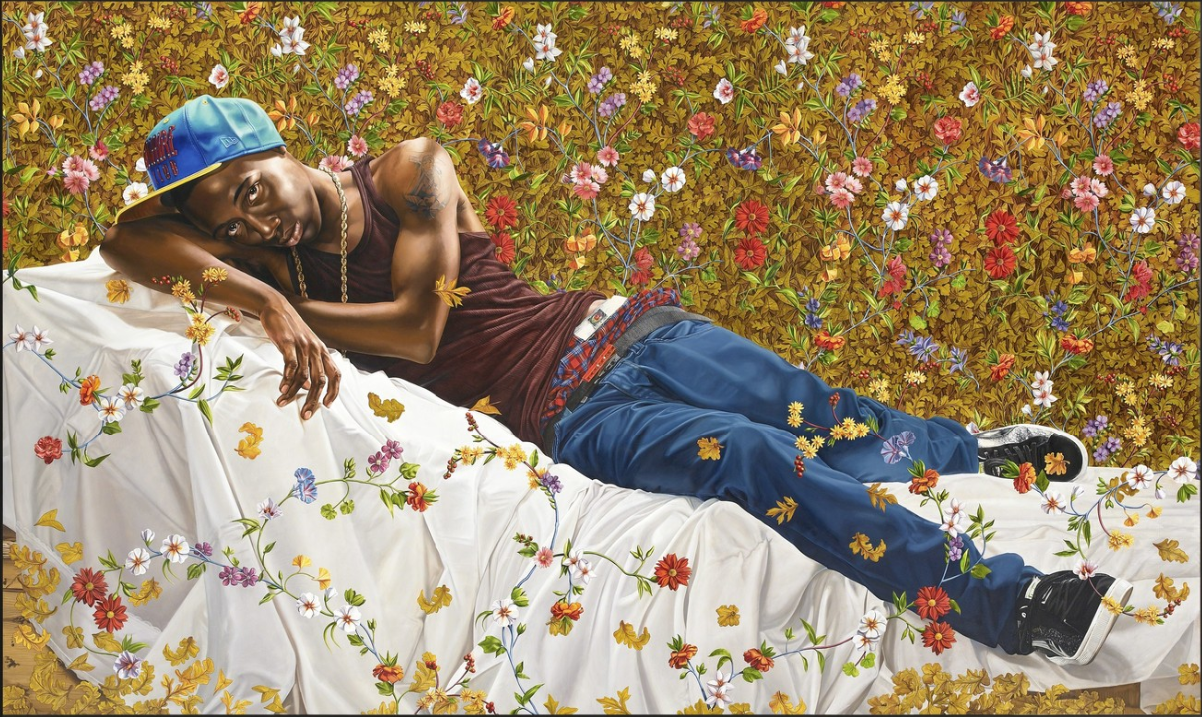
- Genre: Realism
- Location: Seattle Art Museum
A Description of Morpheus
Kehinde Wiley’s Morpheus depicts an African-American man comfortably laying on his side, softly gazing up at the viewer with an almost coy look upon his face. Behind him is a wall of olive toned greenery, flowing from it a multitude of colorful flowers that cascade around him. His dark brown skin appears lit from within, the light perfectly highlighting the deep mounds of his biceps without obscuring his tattoo of Jesus Christ on his upper bicep.
Gently leaning on an ivory white silk blanket, the subject displays his entire outfit: a black and grey pair of Air Jordan-esque sneakers, merlot red wife beater, an over-sized gold chain, and currant red plaid boxers—exposed by his sagging navy blue jeans.
The subject’s urban style, coupled with his African-American male identity, yields a captivating image of contemporary African-American culture represented in traditional European portraiture.
Wiley uses the tool of malleability, found in much visual rhetoric, through the means of appropriation. This is refers to recognizing the old image in the new image, helping us understand the meaning of a visual text, embedded by the artist/author themselves. (D’Angelo 3) In Morpheus, Wiley achieves this by replacing the mythological Greek god of dreams, Morpheus, in Pierre-Narcisse Guérin’s Morpheus and Iris (1811) with the African-American subject previously described.
More than Just a Painting
Considering how Wiley’s artwork is displayed in well-known galleries, such as the Brooklyn Museum, one could comfortably infer that this artwork must contain some cultural significance. Why would the artworld confer the status of “art” to it and display it at such a distinguished gallery if it did not have immense cultural significance?
There is no clear and distinct answer to this, except that his artwork has emerged in the perfect social and cultural environment to receive it. This would mean it is a living piece of material culture.
One could infer, quite reasonably, that the recent increase in public awareness of injustices against African-Americans and the LGBTQ community has created the social, cultural, and historical state necessary for an artwork like Morpheus to be created.
Visual Analysis of Morpheus
With the nature of Morpheus understood, one can begin to assess the three interconnected components of rhetoric: text, audience, and author. By understanding the nature of the text, we can begin to understand its purpose and subject.
Regarding Morpheus, the genre of the text is clearly a painting. The colorful floral background of the piece and relaxed body language of the subject is inherently subversive— rebelling against the patriarchal, white supremacist, heteronormative, and hyper-masculine institutions of oppression and the vilification of African-American men.
The disruptive nature of Wiley’s pieces is immediately recognizable by viewers—as any person, admittedly or not, senses that something seems out of place in his pieces. But before analyzing the audience, the authors role in the text should be considered.
Kehinde Wiley’s identity should not be ignored during a visual analysis of his work, for the authors identity adds to a texts visual rhetoric. Just this past February, Wiley unveiled the final product of his commissioned presidential portrait of Barack Obama. This alone adds to Wiley’s ethos, granting him credibility in regards to his artistic skills and influence in the artworld.
Unbeknownst to many, Wiley’s commissioning was a historical moment for America—as Kehinde Wiley is the first African American and first openly gay individual to be commissioned for a presidential portrait. Without acknowledging this remarkable accomplishment, one would not only have a shallow understanding of his work, but be participating in the harmful erasure of queer African American men shaping American history.
When regarding Kehinde Wiley’s work, an audience could not possibly understand it through a disinterested point of view. The attitude of the audience determines how the work will be received. Subsequently, this also determines whether their reaction will be self-reflective, or not. Kehinde Wiley’s exhibition, A New Republic, not only exposes how African-American identity is represented in the artworld, but how the harmful effects of it have infiltrated our own perceptions of people of color and queer individuals in general.
Why is it that one feels the subject in Morpheus is out of place? What environment would best fit the subject? Who would fit into the floral background of the painting better than him? What does that person look like? How do they identify their sexual orientation?
The, often times conflicting, answers to these questions leads the audience to self-reflect on their own internalized racism and homophobia—leading to a positive change in how people of color and queer individuals are perceived and, consequently, treated in our society.
As a piece of material culture, Kehinde Wiley’s work helps us understand where our society is at in terms of progress, and where it must still change. This broader form of reflection further evidences the significance of Wiley’s work– and I hope to see more revolutionary work like his produced in the future. (Investigating Current Global Affairs).
Details
- Title: Morpheus
- Date Created: 2008
- Physical Dimensions: w1100 x h830 cm
- Painter: Kehinde Wiley
- Type: oil and enamel on canvas
- Location: Seattle Art Museum